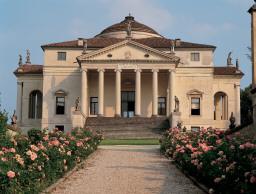London is marking 500 years since the birth of Italy's most influential architect with a major new exhibition paying tribute to Andrea Palladio (1508-1580).
Andrea Palladio: His Life and Legacy opens at the Royal Academy of Arts on Saturday following a hugely successful run in Vicenza, where it drew over 100,000 visitors.
Starting with a famous painting by Spanish artist El Greco, thought to be a portrait of Palladio, the exhibition traces the career of the architect and looks at how his work revolutionized European building design.
In total, over 200 items are on show, including nearly 80 signed Palladio drawings, one of the event's star attractions.
The selection provides valuable insight into Palladio's creative process and also gives visitors the chance to view a number of designs that failed to make it beyond the drawing board, either through lack of money or because they were considered too advanced for their time.
Palladio's designs for the Rialto Bridge in Venice, a new ducal palace and various of his characteristic white villas are among these.
The show features over 40 paintings, which help construct other aspects of the architect's life.
A selection of portraits by great Italian artists of the time, including Paolo Veronese, Titian and Tintoretto, depict figures from Palladio's close circle of friends, as well as his rivals, such as Jacopo Sansovino.
It also showcases a series of idealized 18th-century cityscapes by artists such as Canaletto and Francesco Zuccarelli, who often worked Palladio's structures into their paintings for foreign tourists.
The exhibition, the first London show on Palladio in 30 years, is the result of five years' preparation and spotlights a number of discoveries that emerged during this time.
Of particular interest was the discovery by top Palladian experts from Italy, Britain, France, Germany, Spain and the US that the Renaissance architect had a hitherto unknown penchant for occasional colour.
Palladio's classical designs are famous for their white simplicity but the latest research suggests that a number of works originally incorporated splashes of red.
Traces of red paint have been found on several famous buildings, including the Church of St. George in Venice, whose columns were repainted white in the mid-1600s.
Experts are now convinced that an important element of his original design for the church was the contrast between its fiery red columns and their brilliant white bases.
Palladio, who was born in Padua in 1508, is considered one of the most influential architects in Western history.
Not only did his style become fashionable all over Europe, shaping the work of British architects such as Inigo Jones and Christopher Wren, it also had a strong following in colonial America.
Born Andrea di Pietro dalla Gondola, Palladio spent time in Rome studying and measuring ancient Roman ruins, from which he took much inspiration.
Among his famous works are a series of country villas and urban palaces he designed for the provincial nobility of Vicenza.
From about 1560 to 1580 he built several churches in Venice, notably San Francesco della Vigna, San Giorgio Maggiore, and Il Redentore.
His last great work was the Teatro Olimpico in Vicenza, completed after his death in August 1580.
The Royal Institute of British Architects, which helped curate the London exhibition, has also launched a new website celebrating Palladio and offering visitors an online taste of its extensive collection of his drawings.
Andrea Palladio: His Life And Legacy is on in London until April 13, after which it moves to Washington until autumn 2009.









